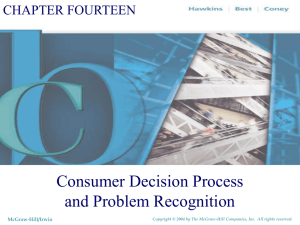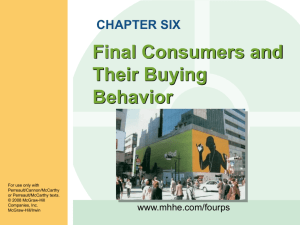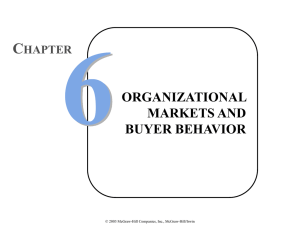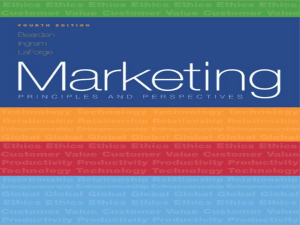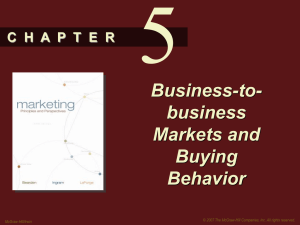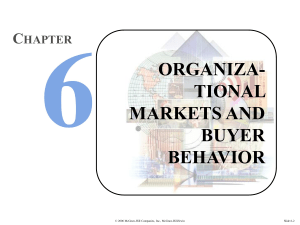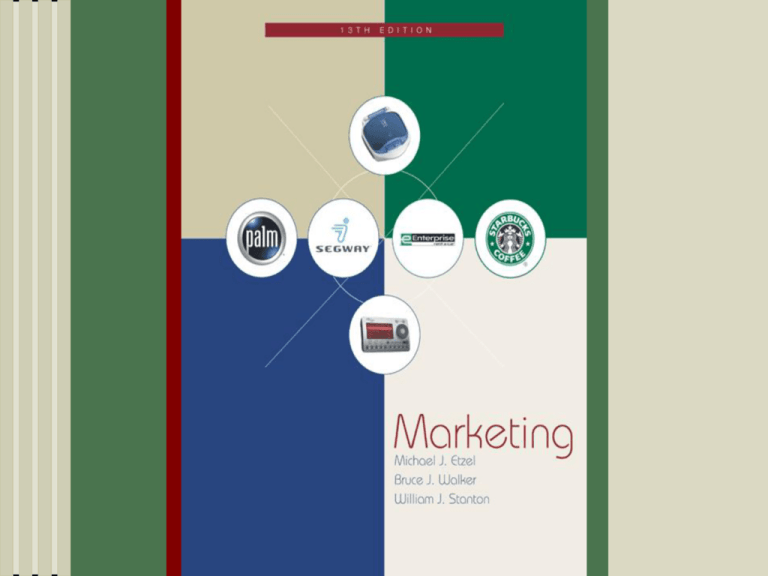
4-1
Chapter 4
Consumer
Markets and
Buying Behavior
4-2
McGraw-Hill/Irwin
Copyright © 2004 by The McGraw-Hill Companies, Inc. All rights reserved.
Chapter Goals
•
•
•
•
Factors used to explain consumer behavior
Consumer demographic changes
Consumers decision-making
Influences affecting consumers’ decisions
4-3
McGraw-Hill/Irwin
Copyright © 2004 by The McGraw-Hill Companies, Inc. All rights reserved.
The Consumer Market
ULTIMATE CONSUMERS
Buy goods and services
for their own personal or
household use
4-4
Geographic Distribution
4-5
Geographic Distribution
Rural
25% of the Population
Urban
75% of the Population
Metropolitan Areas:
MSA
PMSA
CMSA
Suburban Population
4-6
Growing
Deconcentration
Real Growth
Economic, Racial,
Ethnic Implications
Consumer Demographics
Age
4-7
Much Income and financial assets
held by older group
Family
Life Cycle
Family form over time is a
major determinant of consumer
behavior
Education,
Income
Majority are well-educated and
prosperous while 12% live
below poverty
Race,
Ethnicity
African Americans, Hispanics, Asians
Family Life Cycle Stages
Bachelor
Young Married
Nine
stages
with
different
buying
behavior
Full Nest I
Single Parents
Divorced and Alone
Middle-aged Married
Full Nest II
Empty Nest
Older Single
4-8
Consumer Buying-Decision
Process
4-9
Consumer Buying-Decision
Process
Loyalty
Involvement
Impulse
Buying
4-10
Consumer Buying-Decision
Process
Need recognition
Identification of
alternatives
Evaluation of
alternatives
Purchase and
related decisions
Postpurchase
behavior
4-11
Information and Purchase
Decisions
Information
Commercial
sources
Social sources
4-12
Social Influences
Culture
Subcultures
Social class
Reference groups
Families and
Households
4-13
Psychological Influences
Motivation
Perception
Learning
Personality
Attitude
4-14
Maslow’s Hierarchy of Needs
4-15
Perception
Process of receiving, organizing, and assigning
meaning to information or stimuli detected by our five senses
4-16
Selective
Perception
Selective
Attention
Selective
Distortion
Selective
Retention
Personality
An individual’s pattern of traits that influence
behavioral responses
Psychoanalytic
Theory
Hidden buying
motives
Dreams, hopes,
fantasies, fears
Self-concept
Actual
Ideal
4-17
Attitudes
Learned predisposition to respond to an
object in a consistently favorable
or unfavorable way
Characteristics
Learned
Object
Direction
Intensity
Stable
Generalizable
4-18
Situational Factors
When consumers buy
Where consumers buy
Why consumers buy
Conditions under
which
consumers buy
4-19
Situational Influences
Surroundings
Time
Consumer
Moods and
Motives
4-20
Terms
Key Terms and Concepts
• Ultimate consumer
• Metropolitan Statistical Area
(MSA)
• Primary Metropolitan
Statistical Area (PMSA)
• Consolidated Metropolitan
Statistical Area (CMSA)
• Demographics
• Family life-cycle stage
• Consumer buying decision
process
• Level of Involvement
• Loyalty
4-21
McGraw-Hill/Irwin
• Impulse buying
• Patronage buying motives
• Postpurchase cognitive
dissonance
• Commercial information
environment
• Social information
environment
• Culture
• Subculture
• Social class
• Reference groups
Copyright © 2004 by The McGraw-Hill Companies, Inc. All rights reserved.
Key Terms and Concepts
•
•
•
•
•
•
•
Family
Household
Motive
Maslow’s need hierarchy
Perception
Selective perception
Learning
4-22
McGraw-Hill/Irwin
•
•
•
•
•
•
Stimulus-response theory
Personality
Psychoanalytic theory
Self-concept
Attitude
Situational influence
Copyright © 2004 by The McGraw-Hill Companies, Inc. All rights reserved.

